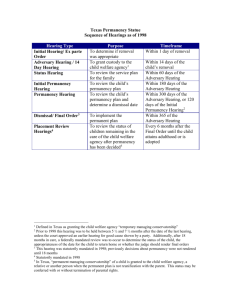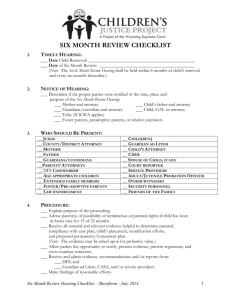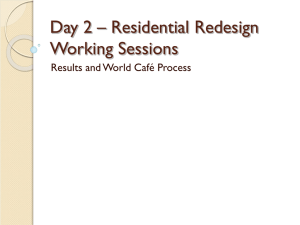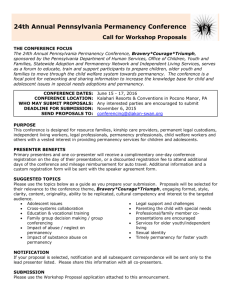Texas Judicial System - National Association of Counsel For Children
advertisement
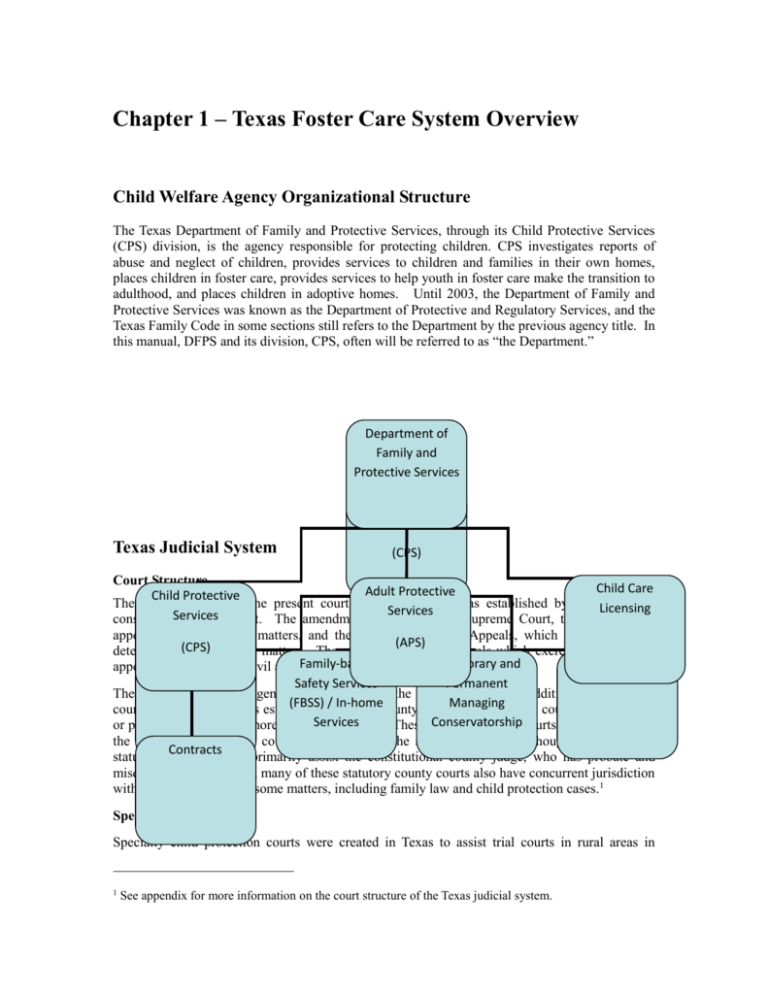
Chapter 1 – Texas Foster Care System Overview Child Welfare Agency Organizational Structure The Texas Department of Family and Protective Services, through its Child Protective Services (CPS) division, is the agency responsible for protecting children. CPS investigates reports of abuse and neglect of children, provides services to children and families in their own homes, places children in foster care, provides services to help youth in foster care make the transition to adulthood, and places children in adoptive homes. Until 2003, the Department of Family and Protective Services was known as the Department of Protective and Regulatory Services, and the Texas Family Code in some sections still refers to the Department by the previous agency title. In this manual, DFPS and its division, CPS, often will be referred to as “the Department.” Department of Family and Protective Services Child Protective Services Texas Judicial System (CPS) Court Structure Child Care Adult Protective Child Protective The basic structure of the present court system of Texas was established by an 1891 state Licensing Services Services constitutional amendment. The amendment established the Supreme Court, the highest state appellate court for civil matters, and the Court of Criminal Appeals, which makes the final (APS) (CPS) determination in criminal matters. There are 14 courts of appeals which exercise intermediate Family-based Temporary and Adoption appellateInvestigations jurisdiction in civil and criminal cases. Safety Services Permanent The state trial courts of general jurisdiction are the district courts. In addition to these state (FBSS) / In-home Managing courts, the Legislature has established statutory county courts, designated as county courts at law Services Conservatorship or probate courts, in the more populous counties. These statutory county courts are in addition to the county court in each county established by the state constitution. Though most of these Contracts statutory county courts primarily assist the constitutional county judge, who has probate and misdemeanor jurisdiction, many of these statutory county courts also have concurrent jurisdiction with the district courts in some matters, including family law and child protection cases.1 Specialty Courts Specialty child protection courts were created in Texas to assist trial courts in rural areas in 1 See appendix for more information on the court structure of the Texas judicial system. managing their child abuse and neglect dockets. Like child support associate judges, also known as Title IV-D judges, the associate judges who hear child protection cases are appointed by regional administrative presiding judges. Although the child protection court judges receive their appointments from the regional administrative presiding judges, they are state employees of the Texas Office of Court Administration. At the discretion of the regional administrative presiding judge, visiting judges may also be appointed to hear these cases in lieu of associate judges. Child protection specialty court judges solely hear child abuse and neglect cases. Currently, there are 17 child protection specialty courts operating in 130 counties. In fiscal year, 2008, these courts held 23,687 hearings and issued 5,429 final orders.2 2 Texas Office of Court Administration. For more information on the specialty courts available at http://www.courts.state.tx.us/courts/specialty.asp. Timeline of Legal Case – Statutorily Mandated Road to Permanency Brief Overview of DFPS Legal Case Timeline Day Legal Event_______________ 0 DFPS appointed TMC 14 1st Adversary Hearing 60 Status Hearing 180 1st Permanency Hearing 300 2nd Permanency Hearing Between 300 and 365+ Trial/Final Order* Day Legal Event_______________ 1st Monday after Day 365+ Dismissal Date; trial on merits commenced unless dismissal date extended Between 365 and 540 Trial/Final Order* 420 3rd Permanency Hearing 540 Final Dismissal Date *IF CHILD REMAINS IN FOSTER CARE, HEARINGS, CALLED PLACEMENT REVIEW HEARINGS TO DISTINGUISH THEM FROM PERMANENCY HEARINGS, MUST CONTINUE AT LEAST EVERY 180 DAYS, AND IN SOME CASES MORE FREQUENTLY FOLLOWING THE FINAL ORDER. Day 0 Activities Required Discussion and Comments3 Emergency removal without court order. §262.104 If the emergency possession is without a court order, an ex parte hearing must be held on the “first working day” but no later than 3 days after the removal. §262.106. Possession with intent to return to caretaker. Whether the possession is by police under §262.007 or the Department under §262.110, the Department has five days to either return the child or file suit. Emergency removal (with prior ex parte order). The 365-day clock starts when the Department gets Temporary Managing Conservatorship (TMC), which may be ex parte. §105.001(h). Appointment of ad litem (GAL & AAL) for the child required immediately after filing. §§107.011 & 107.012. Removal and TMC order may also be after an adversary hearing. §262.205 0 Initial hearing and order; may be §262.106 hearing, or “full adversary hearing.” 14 “Full adversary hearing” -temporary orders or return to [or 0] parent required. §262.201. If the child remains in care, the court must appoint the Department as TMC and start the clock. 15 If the court has rendered temporary orders, the Department must request the identity of Court of Continuing Jurisdiction. §262.202. Request for identification of court of continuing jurisdiction; motion to transfer. §155.201 et seq. Court must inform each parent in open court that parental rights may be restricted or terminated unless the parent is willing and able to provide a safe environment for the child. §262.201(c); §262.205(c) (2). Appointment of counsel for indigent parent who responds in opposition to the Department’s lawsuit required if Department seeks termination or TMC. §262.013(c). DFPS must file redacted copy of §261.307 child placement resources form and explanation of why placement not made with designated caretaker. §262.114(a-1) & (a-2). If form not filed, court must require parent to complete and file the form at hearing. §262.201(c). Motion to transfer may be filed outside the time limits in Chapter 155. §262.203(b). The court hearing the Department’s case may determine the transfer issue if transfer is mandatory §262.203(a) (2); transfer is not required until the CPS case has been resolved if the basis for transfer is a divorce suit filed in another county. §262.203(c). 45 3 File service plan. The Department must file its service plan. §263.101. All cites in timeline refer to the Texas Family Code unless otherwise noted. 60 Status hearing. Court must hold hearing to review child’s status and the service plan within 60 days after TMC is awarded. §263.201. Requirement includes child in Texas Youth Commission custody. §263.002(2). Unless child is in adoptive or other permanent placement, DFPS must file redacted copy of §261.307 child placement resources form 10 days before hearing. §263.003. Court must inform each parent in open court that parental rights may be restricted or terminated unless the parent is willing and able to provide a safe environment for the child. §263.006. Court must conduct a “judicial review of medical care” as mandated by §266.007; the foster child shall be provided an opportunity to express to the court the child’s views of the medical care being provided. §266.007(c) 170 Permanency Progress Report Notice of the first permanency hearing must be given to foster parent, and Notice of Initial "preadoptive" parent, relative caretaker, ad litem attorney, CASA, and Permanency Hearing other listed interested persons, 10 days prior to hearing. §263.301(b). A copy of the Department’s permanency plan must be given to each of the persons entitled to notice at least 10 days prior to the permanency hearing. §263.3025(a). The Department is not required to search for relatives if the child has been abandoned under the "Baby Moses" law and the Department does not have information concerning the identity of the child or the child's parents. §263.3025(a). The permanency progress report must (1) recommend that the suit be dismissed, or (2) recommend that the suit continue and : (A) identify the dismissal date; (B) provide: (i) the name of any person entitled to notice under Chapter 102 who has not been served; (ii) a description of the efforts by the department or another agency to locate and request service of citation; and (iii) a description of each parent's assistance in providing information necessary to locate an unserved party; (C) evaluate the parties' compliance with temporary orders and with the service plan; (D) evaluate whether the child's placement in substitute care meets the child's needs and recommend other plans or services to meet the child's special needs or circumstances; (E) describe the permanency plan for the child and recommend actions necessary to ensure that a final order consistent with that permanency plan, including the concurrent permanency goals contained in that plan, is rendered before the date for dismissal of the suit under this chapter; (F) with respect to a child 16 years of age or older, identify the services needed to assist the child in the transition to adult life; and (G) with respect to a child committed to the Texas Youth Commission or released under supervision by the Texas Youth Commission: (i) evaluate whether the child's needs for treatment and education are being met; (ii) describe, using information provided by the Texas Youth Commission, the child's progress in any rehabilitation program administered by the Texas Youth Commission; and (iii) recommend other plans or services to meet the child's needs.. §263.303(b).The report should include a summary of medical care for the child, or a separate summary should be distributed to the court and the persons listed in §266.007(b). A parent or attorney for either the parent or the child may file a response to the permanency report not later than 3 days prior to the hearing. §263.303(c). 180 Initial Permanency Hearing. §§263.304; 263.306 Court must review locating/service efforts, including cooperation of parties before the court. §§263.301(c); 263.306(a) (2) & (3). Child must attend unless specifically waived by court. A child committed to the Texas Youth Commission may attend a permanency hearing in person, by telephone, or by videoconference. The court shall consult with the child in a developmentally appropriate manner regarding the child's permanency plan, if the child is four years of age or older and if the court determines it is in the best interest of the child. §263.302. Court must conduct a “judicial review of medical care” as mandated by §266.007; the foster child shall be provided an opportunity to express to the court the child’s views of the medical care being provided. §266.007(c) Court must inform each parent in open court that parental rights may be restricted or terminated unless the parent is willing and able to provide a safe environment for the child. §263.006. Specific additional duties of the court under §263.306(a): (1) Identify all persons present at hearing or those given notice but failing to appear; (2) review the efforts of the department to locate and serve necessary persons and obtaining the cooperation of a parent in those efforts; (3) review the efforts of each custodial parent, alleged father, or relative of the child before the court in providing information necessary to locate another absent parent, alleged father, or relative of the child; (4) return the child to the parent or parents if in the child's best interest and parent willing and able to provide the child with a safe environment; (5) place the child with a person or entity willing and able to provide the child with a safe environment in child’s best interest; (6) evaluate the department's efforts to identify relatives who could provide the child with a safe environment; (7) evaluate the parties' compliance with temporary orders and the service plan; (8) determine whether: (A) the child continues to need substitute care; (B) the child's current placement is appropriate for meeting the child's needs, whether that placement continues to be in the best interest of the child; and (C) other plans or services are needed to meet the child's special needs or circumstances; (9) if the child is placed in institutional care, determine whether efforts have been made to ensure placement of the child in the least restrictive environment consistent with the best interest and special needs of the child; (10) if the child is 16 years of age or older, order services that are needed to assist the child in transition to independent living; (11) determine plans, services, and further temporary orders necessary to ensure that a final order is rendered before the date for dismissal of the suit under this chapter; (12) if the child is committed to the Texas Youth Commission or released under supervision by the Texas Youth Commission, determine whether the child's needs for treatment, rehabilitation, and education are being met; and (13) determine the date for dismissal of the suit under this chapter and give notice of deadline and hearings. Specific additional duties of the court under §263.306(b): (1) determine: (A) the safety of the child; (B) the continuing necessity and appropriateness of the placement; (C) the extent of compliance with the case plan; (D) the extent of progress that has been made toward alleviating or mitigating the causes necessitating the placement of the child in foster care; and (E) whether the department has made reasonable efforts to finalize the permanency plan that is in effect for the child, including the concurrent permanency goals for the child; and (2) project a likely date by which the child may be returned to and safely maintained in the child's home, placed for adoption, or placed in permanent managing conservatorship. 290 Permanency Progress Report. DFPS must file a permanency progress report and serve it on all parties at least 10 days prior to each permanency hearing. §263.303. 300 Permanency Hearing. Court may shorten, but may not extend the 120-day deadline for subsequent permanency hearings. §263.305. Required findings and orders are the same for subsequent as for initial permanency hearing. §263.306(a). 364 Extension order. The court may extend the time by not more than 180 days from the original deadline. §263.401(b). The court may not grant an extension beyond the authorized 180 days. §263.401(c). The parties may not agree to extend the deadlines set by the court. §263.402(a). However, a motion to dismiss made after the court commences the trial on the merits is untimely and waives the objection. § 263.402(b). The court may place the child with a parent for up to 180 days of monitoring without regard to the deadlines, and special rules apply to removals from this "monitored placement" with a parent. §263.403. See "special rule" below. The trial court must “commence” the trial on the merits not later than the first Monday after the first anniversary of the date the trial court granted DFPS TMC. § 263.401(a). Final orders appointing the Department as permanent managing conservator without terminating parental rights to make adoption possible are discouraged. § 263.404. Limitation on Permanency Plans: (a) The department's permanency plan for a child may include as a goal: (1) the reunification of the child with a parent or other individual from whom the child was removed; (2) the termination of parental rights and adoption of the child by a relative or other suitable individual; (3) the award of permanent managing conservatorship of the child to a relative or other suitable individual; or (4) another planned, permanent living arrangement for the child. (b) If the goal of the department's permanency plan for a child is to find another planned, permanent living arrangement for the child, the department shall document that there is a compelling reason why the other permanency goals identified in Subsection (a) are not in the child's best interest. §263.3026 [eff. 6/19/09] 365 Commence trial or dismiss case deadline. (Actually the “first Monday” following the one-year anniversary) 410 Permanency Progress Report DFPS must file a permanency progress report and serve it on all parties (during extension). at least 10 days prior to each permanency hearing. §263.303. 420 Permanency Hearing (during All requirements for initial permanency hearing apply. §263.306. extension). 540 Final Deadline; final “permanency hearing” scheduled. Case must be dismissed 180 days after the first Monday following the first anniversary of the date TMC was granted to DFPS unless: trial on the merits has commenced; or the child has been placed with a parent for up to 180 days of monitoring. If a permanency hearing is scheduled on this date, it will be within days, if not hours of the absolute deadline for merits trial or dismissal. ** Special rule when temporary The court may, in lieu of a final order, continue DFPS as temporary placement for monitoring managing conservator for not more than 180 days with the child placed breaks down. in the home of a parent for monitoring. §263.403(a). The court order must include specific findings of the grounds for the order, and must establish a dismissal date not more than 180 days after the order is rendered. §263.403(b). If DFPS removes the child during the monitoring period, the deadline for dismissal or merits trial is the original dismissal date or 180 days after the removal of the child, whichever is later. § 263.403(c). Placement Review Hearings If the final order appoints DFPS as the managing conservator of the child, without termination of parental rights, the court must continue to review the placement of the child at least every six months until the child is placed for adoption or becomes an adult. §263.501(a). If the final order appoints DFPS as the managing conservator of the child, with termination of parental rights, the court must hold a placement review hearing not later than the 90th day after the date the court renders the final order. The court shall conduct additional placement review hearings at least once every six months until the date the child is adopted or the child becomes an adult. §263.501(b). Remaining parties are entitled to notice [parents whose rights are terminated are no longer parties]. §263.501(d). Placement review reports must be filed 10 days before each hearing. If parental rights have not been terminated, the report must describe the efforts of the department to find a permanent placement for the child, including efforts to: (A) work with the caregiver with whom the child is placed to determine whether that caregiver is willing to become a permanent placement for the child; (B) locate a relative or other suitable individual to serve as permanent managing conservator of the child; and (C) evaluate any change in a parent's circumstances to determine whether: (i) the child can be returned to the parent; or (ii) parental rights should be terminated.§263.502(c) [eff. 6/19/09]. The court must review the placement in much the same manner as before the final judgment, and must evaluate the Department's efforts to finalize the permanency plan for the child, such as to obtain an adoptive placement, reunify with a parent or file a new suit for termination. §263.503(a). The court may order services for the parent under certain circumstances. §263.503(b). The court must also continue to review the child’s medical care as required by Chapter 266. The court may extend jurisdiction over a foster child beyond age 18 to age 21 with the consent of the youth. §§263.601, et. seq. [eff. 5/23/09] Reasonable Efforts Required throughout the Department’s Case The Adoption Assistance and Child Welfare Act (AACWA, Pub L. 96-272), enacted in 1980, originally mandated that states make reasonable efforts to eliminate the need to remove the child from the home and to make reasonable efforts to reunify the child with the family in a timely manner. Title IV-E of the Social Security Act requires that CPS make reasonable efforts to prevent removal of children from their homes, and once removed and placed in foster care to make reasonable efforts to return of children to families, or when that is not possible, place them in a safe, stable and permanent home.4 The Adoption and Safe Families Act of 1997 (ASFA, Pub. L. 105-89) clarified that while reasonable efforts must be made, the child’s health and safety are the paramount concern in determining what is reasonable and consistent with the child and family permanency plans. At all stages of a CPS case, judges are required to determine whether the Department has made and is making reasonable efforts to achieve permanency. The Texas Family Code requires judges to ensure that the family service plan adequately ensures reasonable efforts are made to enable to child’s parents to provide a safe environment for the child, and whether the Department has made efforts to finalize the child’s permanency plan in effect. The inquiry is case specific, and requires courts to explore the different efforts to keep families together or to find permanent homes for children who cannot live safety with their parents. Texas Family Code §262.102 requires the court to make a finding that reasonable efforts were made to prevent or eliminate the need to remove the child.5 Texas Family Code §262.201, which governs the 14-day or Adversary Hearing, requires the court to make a finding that reasonable efforts were made to enable the child to return home, but that a substantial risk of continuing danger exists if the child is returned,6 and Texas Family Code §263.202, which governs the Status Hearing, requires the court to find whether a plan that has a goal of reunification ensures reasonable efforts are made to enable to child’s parents to provide a safe environment for the child.7 Finally, §263.306, which governs the Permanency Hearings conducted throughout the case, requires that in its review of the service plan, the court determine whether the Department has made reasonable efforts to finalize the permanency plan that is in effect for the child.8 Although the Family Code requires that the Department to make reasonable efforts with regard to the plan put in place, courts have held that “reasonable efforts” are not required to terminate a parent’s rights.9 Only two termination grounds require the Department to make reasonable efforts before a parent’s rights can be terminated: 1) Constructive Abandonment under Texas Family Code §161.001(1)(N), and 2) Inability to Care under §161.003. Otherwise, findings of “reasonable efforts” are important primarily because Federal Financial Participation is affected by the Department’s efforts in this regard. 4 42 U.S.C. §§ 671-679b. Tex. Fam. Code § 262.102(a) (3). 6 Id. § 262.201(b) (3). 7 Id. § 263.202. 8 Id. § 263.306(b) (1) (E). 9 Jones v. Dallas County Child Welfare Unit, 761 S.W.2d 103, 109 (Tex. App. – Dallas 1988, writ denied). 5 In April 2009, the National Council of Juvenile and Family Court Judges issued a Reasonable Efforts Policy Statement making clear that while child welfare agencies reasonable efforts may be constrained by budgetary and economic issues, judicial findings must be based on the services a family truly needs. Even in times of a budget crisis, and in the face of child protection agency officials’ arguments that budget restrictions may relieve an agency of making reasonable efforts, the federal law does not provide such an exception. The Council stated that because the inquiry is case specific, and requires the court to vigorously explore efforts made to keep families together to find permanent homes; federal law does not allow exceptions to this requirement regardless of budget constraints. 10 Funding Streams Another important aspect of child protection cases involves funding streams. Child protection matters receive funding through a combination of state and federal sources. CAPTA provides three funding streams: Community-based funding, Child Abuse State Grants, and Child Abuse Discretionary Grants. To receive CAPTA money, states must apply to the U.S. Department of Health and Human Services. States are required to demonstrate that they have a comprehensive program for mandatory reporting of suspected child maltreatment; methods for responding to reports and assessing whether there is sufficient evidence to validate the report; and systems for taking action that are appropriate to the level of risk of harm to the child involved.11 Title IV-E and IV-B of the Social Security Act establish funding streams for the prevention of child abuse and neglect and for alternative placements when a child cannot safely be returned home.12 The provisions do not create substantive law; however, states face financial penalties for failure to comply. Sources of funding include: 10 Foster Care Reimbursement Payments (Title IV-E) are the largest federal expenditure in response to child abuse and neglect. Federal money is matched by state dollars to cover the costs of Foster care maintenance, administration and training. Adoption Assistance (Title IV-E) federal funds are matched by state dollars to support adoption related maintenance, administration, and training. Promoting Safe and Stable Families Program (Title IV-B, subpart 2) federal funding is dedicated to child abuse and neglect prevention services, including money for court improvement. Child Welfare Service Program (Title IV-B, subpart 1) funding is not targeted to a specific use, but available as general federal child abuse and neglect service funds. NCJFCJ Judicial Responsibility Policy Statement, available at www.ncjfcj.org. 42 U.S.C. § 5106(a). 12 Id. §§ 622, 670. 11

